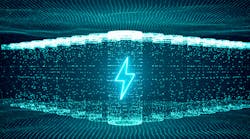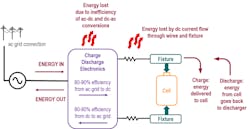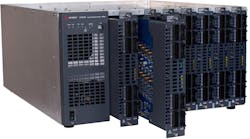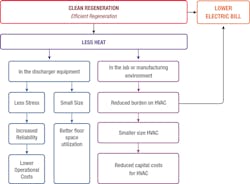Reap the Benefits of Regeneration When Testing or Forming Li-Ion Cells
What you'll learn:
- The move from ICE to hybrid and fully electric vehicle will continue to require inordinate research and testing of new cells.
- Implementing ac regeneration for the many charge-discharge cycles during testing.
- Two technical issues to consider if you're using regeneration.
In the automotive industry, great efforts are being made to attain a greener world. Major automakers are transforming their lineups from internal combustion engines (ICE), to hybrids, to full electric vehicles. Many state they will discontinue ICE altogether and offer only electric vehicles in the next decade. Governments, too, are enacting policy to push for the transformation of the gasoline car to the electric car.
This will require the manufacturing of many batteries. For now, the chemistry of choice for cells that go into automotive batteries is the lithium-ion rechargeable cell. To give an automotive user experience that’s consistent with ICE, cells must come down in price and have greater capacity (for greater vehicle range) and faster charging (for a gasoline-like refueling time). To accomplish this, cell makers will need to spend billions of dollars on research and testing new cells, plus build many new factories to churn out cells at rates that are 10X greater than we can today.
Regeneration for a Greener World
Each cell tested will need to be charged and then discharged. Many tests require repeated charge-discharge cycles. Likewise, during cell manufacturing, every cell will undergo charging and discharging during the cell formation process. During charge, energy will be taken from the ac line, converted to dc, and used to store energy in the cell. Every cell manufactured or tested will consume ac power as an unavoidable cost of the charging operation.
On the other hand, discharging pulls stored energy out of the cells. You can convert that energy to heat and waste the energy, but it’s not a green approach. Going green means regeneration, which is a highly sought-after method to recoup that energy, converting it to dc power or ac power, and reusing the energy instead of wasting it. Most often, the regeneration is ac, which puts the energy from the discharging cells back onto the ac line. In this article, I’ll cover ac regeneration, since it’s more common. I’ll reserve a future article to cover dc regeneration.
Regeneration Efficiency
In Figure 1, you can see the energy flow from the ac line through the power-conversion system of the charger, through the wiring and fixture, to the cell during charge. Figure 1 also reflects discharging with regeneration.
1. Energy flow, efficiency and losses during cell charging and discharging.
It’s important to note that not all energy stored in the cell can be returned to the ac line through regeneration. The current flow through the wires will cause a voltage drop through the resistance of the wires. The wires will therefore generate heat, stealing away some of the available energy that was destined for regeneration. Thus, keeping wires short and at low resistance will help to reduce the heating effect in the wires and, therefore, permit more discharge energy to return to the discharger’s regeneration circuitry. The discharger will convert the dc power coming from the cell to ac power.
Discharger circuits are designed to be efficient, but normally will achieve somewhere between 80% to 90% dc to ac conversion efficiency. Discharge circuits pass most of the energy back to the ac line, but conversion inefficiency means heat is generated in the discharger and that heat takes 10% to 20% of the energy from getting regenerated back on the ac line.
Consequently, considering energy lost in the wires and energy lost in the regeneration conversation, the overall regeneration efficiency that can be achieved is typically in the 75% to 85% range. Recouping 75% of the power is a big savings, but the remaining 25% is lost to heat on each charge/discharge cycle. While regeneration is a savings, you can’t get back all of the energy you put in during a charge.
Another consideration of regeneration is the effect on the overall power consumption of the test lab or factory. Due to the inefficiencies described above, it’s unlikely that regeneration will ever exceed the power required for charging. This means the ac meter on the side of the building will always run in the forward direction, where you pay the power company, and not the other way around. Regeneration will lower the electrical bill, but not zero it out.
Technical Considerations of Regeneration
While regeneration is a strong benefit, there are two technical considerations to examine. For safety reasons, regeneration systems must shut down if the grid power is lost. The regeneration system should not try to power the grid. For example, if the power goes out, and a power company technician goes to the transformer to begin repairs, they expect the power to be gone.
However, if your regenerative discharger is putting power back on the ac line, it becomes an unknown generator that’s hazardous to the power company technician. Therefore, properly designed regeneration systems have a feature called anti-islanding, whereby the regeneration system can’t be an island of power that continues to generate when there’s no functioning grid.
The second consideration is electrical performance and noise generation. To put power back on the ac line, the regenerative discharge circuits sense the ac line, then generate the ac power at the correct frequency and voltage to push energy back onto the grid. The ac power circuits that are converting dc power to ac power can introduce electrical noise on the ac line.
IEEE standard 519 provides industry-recommended practices and requirements for harmonic control in electric power systems. The standard requires total harmonic distortion (THD) of less than 5%. A high-quality regeneration system will have power factor correction approaching power factor = 0.99 and THD much better than 5%. Figure 2 shows an example of a regenerative charger-discharger that meets these requirements.
2. Keysight’s BT2200 charger/discharger for cell formation, cell cycling, and cell testing employs ac regeneration when discharging 256 cells at 6 A or from 16 cells at 100 A.
Summary: Use Regeneration to Go Green
Without regeneration, the only option is to dissipate the energy in the cells as heat. That heat is carried away by water cooling or by air cooling. In either case, it’s mostly wasted energy. Removing waste heat requires additional power for water pumps or fans or air-conditioning systems. The additional building infrastructure to hold the water pipes and pumps or the fan ducts and air-conditioning systems means more energy is used to build and maintain the building.
Regeneration reduces excess heat into the test environment (Fig. 3). Therefore, HVAC systems are less stressed and can be sized smaller. Furthermore, the reduction of excess heat means less heat is generated inside the discharging equipment. And less heat stress on the equipment results in smaller-sized equipment and higher reliability. So, regeneration benefits go beyond just the money saved by reusing waste energy of the discharging cells.
3. Benefits of regeneration with lab or manufacturing equipment for testing Li-ion cells or batteries.




